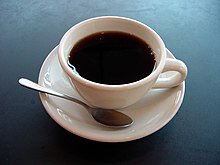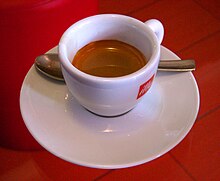Talk:Italian meal structure
| This is the talk page for discussing improvements to the Italian meal structure article. This is not a forum for general discussion of the article's subject. |
Article policies
|
| Find sources: Google (books · news · scholar · free images · WP refs) · FENS · JSTOR · TWL |
| This article is rated C-class on Wikipedia's content assessment scale. It is of interest to the following WikiProjects: | ||||||||||||||||||||||||||||
| ||||||||||||||||||||||||||||
Untitled[edit]
Doesn't colazione still signify any small repast, and isn't "breakfast" still prima colazione in Italian?--Wetman (talk) 13:49, 12 March 2010 (UTC)
1) "Prima colazione" is breakfast where I live (Province of Treviso).
2) "Merenda" is actually any daytime snack, irrespective of what it might say in some Italian-English dictionaries. School children have merenda in the morning and, as a matter of fact, most kids don't go to school in the afternoon.
3) Regarding the structure of meals, for example lunch (pranzo) or dinner (la cena), it might be more correct to include the word "piatto" after "primo" and "secondo" - so it should read "primo piatto" and "secondo piatto".
Pvandck 22:30, 20 September 2010 (UTC) —Preceding unsigned comment added by Pvandck (talk • contribs)
I deleted the part about 'spuntino'. Spuntino is not a part of a traditional meal but every snack eated between the other meals ( http://it.wiktionary.org/wiki/spuntino ) Herdakat (talk) 20:34, 21 November 2010 (UTC)
Inappropriate picture[edit]

The image for primo (copied here) seems entirely inappropriate. My understanding was that spaghetti would never be served with a chunky tomato sauce in Italy; one would use a lighter sauce, or a heavier noodle like tagliatelle.
I think this is supported by the fact that according to the image's description, the sauce is from Kraft Foods... not the most authentic Italian food I can imagine.
I suggest replacing this image with a more authentic primo. Bigpeteb (talk) 20:26, 11 March 2011 (UTC)
Old and new traditions[edit]
Aperitivo is a modern pattern of italian meal: it has been introduced after Second World War. The cheese in Italy was traditionally served after the secondo and before the dolce: this was the old tradition, particulary in Lombardy. Today is more and more rare that someone serves cheese in an articulated meal. The cheese served after the cake is typical of France and England.Lele giannoni (talk) 22:50, 14 December 2011 (UTC)
Piatto principale[edit]
I am Italian from Emilia-Romagna and I have never heard the expression "piatto principale" to indicate a "secondo". Perhaps it is regional (common in a region other than mine), or maybe it is just made up. Actually, I did read it once in the menu of "Romano Macaroni Grill" in the States, where it meant "entrée". --95.89.32.69 (talk) 05:45, 13 May 2013 (UTC)
Change picture?[edit]


First of all, I'm sorry if my English is not perfect, I'm Italian.
I suggest to change the espresso coffee picture with the lower one.
The main fact is that the upper cup is simply huge for any self-respecting Italian coffee. You can use that kind of cup maybe for "macchiato in tazza grande" (macchiato coffee in big cup, similar to cappuccino but with less milk), surely not for an espresso.
I have to say that it's also most probably prepared using a moka pot since it's extremely dark and shows no brown cream/foam on the top. Moka coffee is also common in Italy, especially after a lunch/dinner at home, but it's definitely NOT an espresso. Different taste, smell, density, strength and usually also different quantity (more for moka coffees) and cream (most of times moka coffees come without cream).
99% of times when you go to an Italian restaurant, trattoria or pizzeria you'll have an espresso at the end, not a plain and dark coffee.
At present day, moka coffees are eventually prepared in just some high level restaurants which usually show the "carta dei caffè" (a sort of menu focused only on coffee with different blends and styles of coffee. Eg. espressos, moka coffees, turkish coffees, neapolitan-style coffees prepared with a selection of several different blends) to the customers at the end of the meal and STRICTLY BEFORE the digestivo/ammazzacaffè.--LorenzoIlMagnifico (talk) 09:22, 16 August 2013 (UTC)
Digestivo, ammazzacaffè & co.[edit]
Digestivo doesn't become ammazzacaffè when served after the coffee, digestivo is simply and always served at the end. It ALWAYS comes after the coffee. "Digestivo", "ammazzacaffè", "bicchierino", "cicchino", "chicchetto", "sgroppino", "spirito", etc... all of these terms refer to the same thing. Digestivo and ammazzacaffè are just the more widely known in Italy, but actually they refer to the same thing.
In many regions it's traditionally drunk in the same cup you used for espresso, so it's called in several different ways using local dialects that at the end mean (often but not always) "cup cleaner" ("Risciacquino" in Tuscany, "Resentìn" in Veneto, "Resentines" in Trentino-Alto Adige/Südtirol, "Pussa caffè" in Pedemont, "Scaccinu" in eastern Sicily etc.)
--LorenzoIlMagnifico (talk) 09:29, 16 August 2013 (UTC)
Willfull misconduct[edit]
Merenda doesn't exist in Italian. It is always "spuntino". And for god sakes when will you get off the obsession with "Mediterranean this" "Mediterranean that". It's taken on a whole nother life form like Frankenstein. Plus it's too long of a word and that's not the original name for that sea anyways. There are words abbreviated for the sake of simplicity. Parts of Japan, Vietnam and Taiwan are on the Philippine Sea, should we call them "Filipino countries" from now on? Of course not. It's so forced fed down our throats. Stick to the topic of meal courses. All this biased stuff has nothing to do with it. I don't see anybody calling Sweden a "Baltic country". Despite having a lot more Coastline Italy only has a small Coastline on that sea. and it still doesn't justify it.
This kind of language was unheard of in the 90s and 2000's. There is no such thing as a "European Mediterranean" or a "simply Mediterranean style of eating". that's propaganda brought up by 21st century dividers. Even if it is that's only a small part of Italy not the whole country. 76.167.193.57 (talk) 23:54, 18 June 2022 (UTC)
- "Merenda doesn't exist in Italian" What? from when? I was not aware of it. I will infrom all the pepople around me that that word does not exist! Chetene (talk) 14:59, 23 June 2022 (UTC)
- In Italy, the word merenda is more commonly used than the word spuntino (they're synonymous), especially where I live; in addition, spuntino isn't appropriate in an encyclopedia, because it could refer to the spuntino di mezzanotte (lit. 'midnight snack'; if we're hungry around midnight). JacktheBrown (talk) 01:05, 18 April 2024 (UTC)
Wiki Education assignment: English 102 Section 4[edit]
![]() This article was the subject of a Wiki Education Foundation-supported course assignment, between 9 January 2024 and 3 May 2024. Further details are available on the course page. Student editor(s): K Wilson12 (article contribs).
This article was the subject of a Wiki Education Foundation-supported course assignment, between 9 January 2024 and 3 May 2024. Further details are available on the course page. Student editor(s): K Wilson12 (article contribs).
— Assignment last updated by DoctorBeee (talk) 19:45, 28 February 2024 (UTC)



